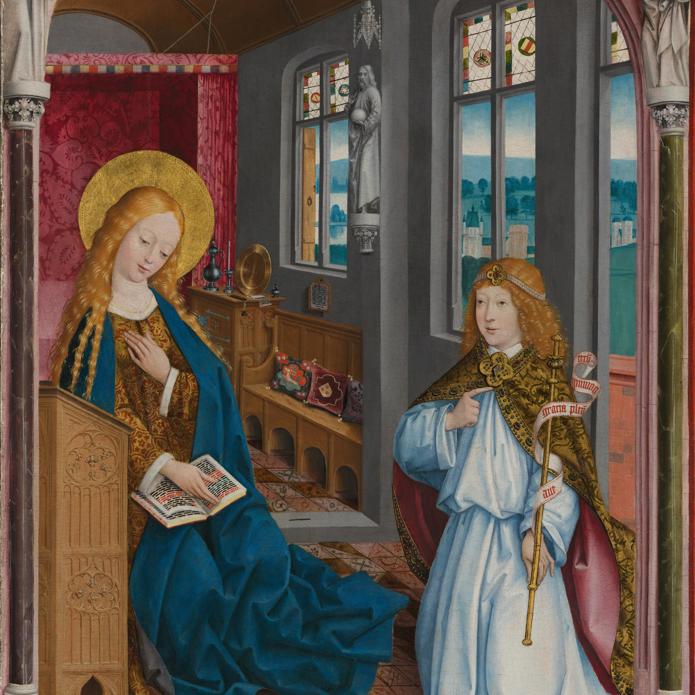Master of Cappenberg (Jan Baegert?), 'Christ before Pilate', about 1520
About the work
Overview
This is one of two panels in the National Gallery’s collection which were once probably part of the shutters of an altarpiece made for the high altar of the Benedictine abbey at Liesborn. The shutters would have been attached to either side of the main panel.
The Roman governor Pontius Pilate was reluctant to condemn Christ to death but feared popular unrest if he did not. According to the Gospel of Matthew, he ‘took water, and washed his hands before the multitude’, saying that he was not to blame for Christ’s death (Matthew 27: 24). Here he is seated on a throne while a servant pours water over his hands into a basin.
Christ stands beside Pilate, his body slumped, looking weary and dejected. He wears the crown of thorns; it has pierced his forehead, and blood runs down his face. His appearance contrasts with the bright colours and the sumptuous fabrics worn by Pilate and his wife, and the deep red patterned textile backing his throne.
Key facts
Details
- Full title
- Christ before Pilate
- Artist dates
- active about 1500 - about 1525
- Part of the series
- The Liesborn Altarpiece
- Date made
- about 1520
- Medium and support
- oil on wood
- Dimensions
- 99.1 × 69.2 cm
- Acquisition credit
- Bought, 1854
- Inventory number
- NG2154
- Location
- Not on display
- Collection
- Main Collection
About this record
If you know more about this painting or have spotted an error, please contact us. Please note that exhibition histories are listed from 2009 onwards. Bibliographies may not be complete; more comprehensive information is available in the National Gallery Library.
Images
About the series: The Liesborn Altarpiece

Overview
These images once formed part of a large altarpiece made for the high altar of the monastery church of the Benedictine abbey at Liesborn, in Westphalia in north-west Germany. The main panel consisted of a central scene of the Crucifixion, flanked on either side by two smaller individual scenes from Christ’s infancy.
In 1517 two shutters painted by the Master of Cappenberg were added to either side of the Master of Liesborn’s original panel. These showed the events leading up to Christ’s crucifixion, his resurrection and events that occurred afterwards, such as the Pentecost.
The altarpiece was removed in the eighteenth century and later cut up; only fragments survive. Six images from the main panel are in the National Gallery’s collection: three fragments of the central Crucifixion, two complete flanking images (The Annunciation and The Presentation in the Temple) and a fragment of The Adoration of the Kings, another flanking scene. Two further images come from the shutters.








